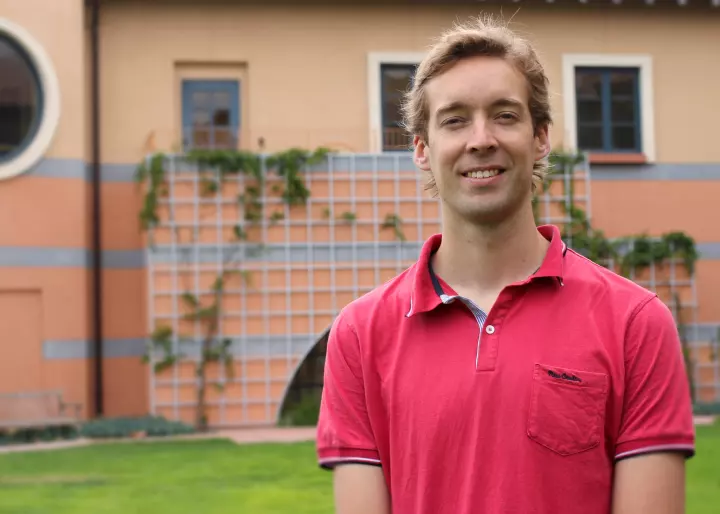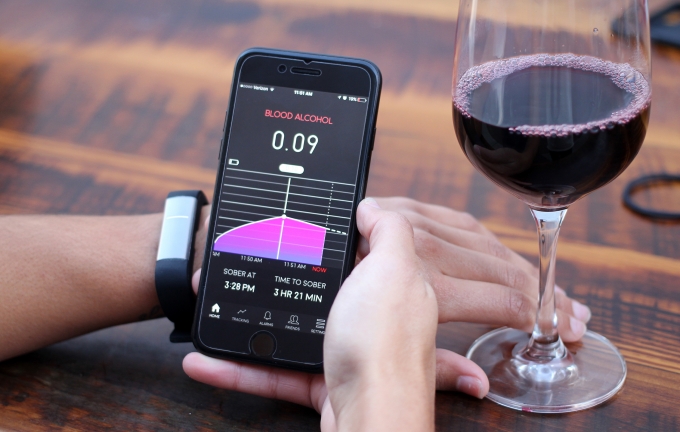Monday, July 31, 2017
“Do you want another drink?” a friend at the bar asks. “Hmmm, let me check,” his buddy responds, tapping a smartphone app that tracks his blood alcohol level, in hopes of avoiding a hangover — or worse.
This fictional scene could become a new reality thanks to an alcohol-detection system, aptly named PROOF. Developed by a team of UC Santa Barbara engineering graduate students, it was named one of the 10 coolest gadgets at this year’s Consumer Electronics Show, the world’s largest annual gathering of tech innovation.
It’s a tremendous endorsement for an idea dreamed up at Pizza My Heart in Isla Vista, according to Bob Lansdorp, who completed his PhD in materials at UCSB’s College of Engineering. While eating pizza, his team was devising some sort of wearable biosensor for the UCSB New Venture Competition in 2015 when “we realized everyone had a beer.” That sparked the idea for an alcohol-detection system.
 After conducting extensive market research, Lansdorp directed the development of PROOF, a wristband biosensor that detects alcohol in the wearer’s system based on perspiration from the skin and relays real-time statistics to an accompanying app on iOS or Android smartphones. Taking the product from concept to reality, Lansdorp relied on his mixed background in mechanical engineering, nanotechnology, and material engineering, fitting the mold of a next-generation engineer who is not confined to a traditional single discipline.
After conducting extensive market research, Lansdorp directed the development of PROOF, a wristband biosensor that detects alcohol in the wearer’s system based on perspiration from the skin and relays real-time statistics to an accompanying app on iOS or Android smartphones. Taking the product from concept to reality, Lansdorp relied on his mixed background in mechanical engineering, nanotechnology, and material engineering, fitting the mold of a next-generation engineer who is not confined to a traditional single discipline. Lansdorp’s team not only won the UCSB competition, obtaining a sizable amount of venture capital in the process, but also went into production this year. Their initial inventory of 650 PROOF units sold out in a week.
“We are creating a new category — wearable biosensors,” said Lansdorp, co-founder and chief technology officer of Milo Sensors Inc. “There are categories of personal breathalyzers, and there are categories of step trackers and heart-rate trackers, but there’s nothing that you can wear that tells you about the chemistry of your body.”
Lansdorp’s success is not surprising to Rod Alferness, dean of the College of Engineering. “Nearly every engineering achievement involves research across multiple disciplines,” he said. “We prepare students to succeed in a collaborative, interdisciplinary professional world. Developing a better insulin monitoring system, creating a faster semiconductor, designing more fuel-efficient cars, landing a spacecraft on Mars, enlisting big data to make everything from farms to skyscrapers operate more efficiently — such achievements are possible only through interdisciplinary research.”
 According to Katie O’Hara, a UCSB PhD.candidate in materials engineering, the possibilities are endless in her field, which is using organic materials to make solar cells and semiconductors.
According to Katie O’Hara, a UCSB PhD.candidate in materials engineering, the possibilities are endless in her field, which is using organic materials to make solar cells and semiconductors. Working with the UCSB materials professor and department chair, Michael Chabinyc, and his research group, O’Hara is focusing on organic molecules that have semiconducting properties and are incorporated into devices like solar cells and transistors. She joked that rather than trying to explain her researchshe to her dad, she tells him she’s working on golf ball technology.
“You can laminate organic solar cells on curved surfaces,” she said, adding that such flexible panels would be lightweight enough to carry while they power your electronic devices. “I think the field has some work that still needs to be done to get to that commercial space, but it’s exciting to be part of something next-generation," she said. "A lot of organic devices would be better for biomedical applications, because these soft organic materials would probably interface better with the body than harder-form materials.”
As she looks forward to graduating, O’Hara is embracing the college’s interdisciplinary approach. “I’d like to do something that would involve electronic materials, or I could go more the organic chemistry route,” she said. “I think I’m going to have to be a little creative with how I apply my skill set.”
O’Hara’s outlook reflects the anything-is-possible perspective that runs deep in the College of Engineering. “We tell prospective students you’ll end up in a career that’s quite likely not even around today,” said Glenn Beltz, mechanical engineering professor and associate dean for undergraduate studies.
“UCSB engineers do fairly well for themselves in terms of going on to some kind of greatness after they graduate,” he said, noting that the competition to get into the program has “become a lot more fierce” in the past ten years.
Related People:
Michael Chabinyc 
The alcohol detection app, PROOF, in action
